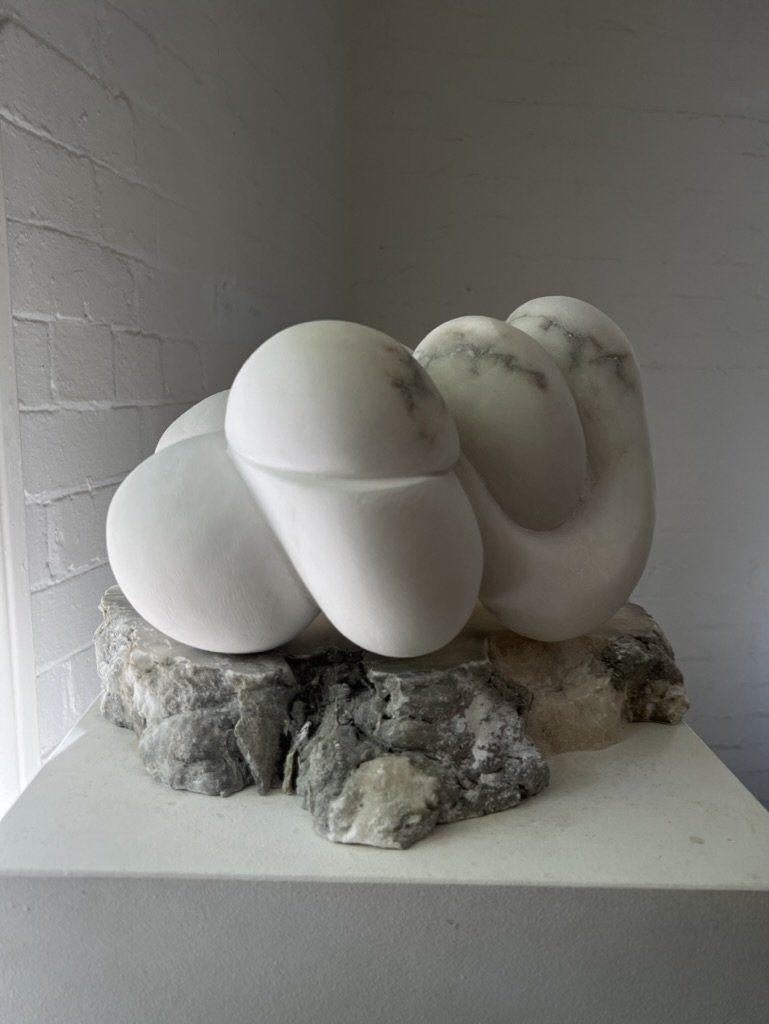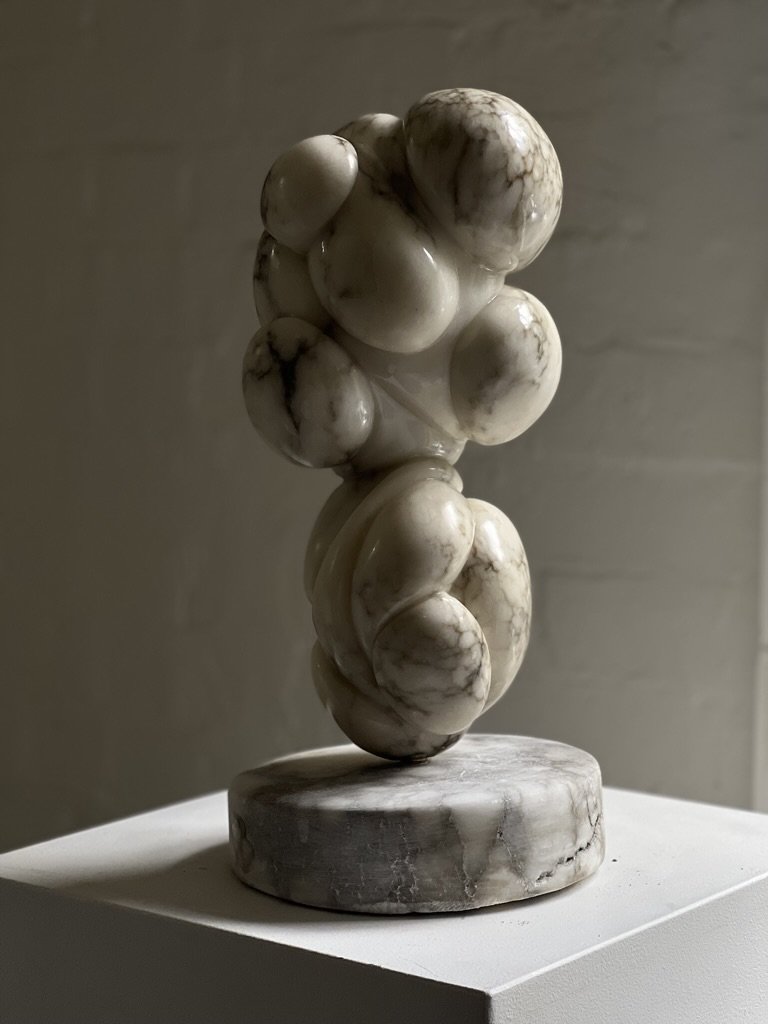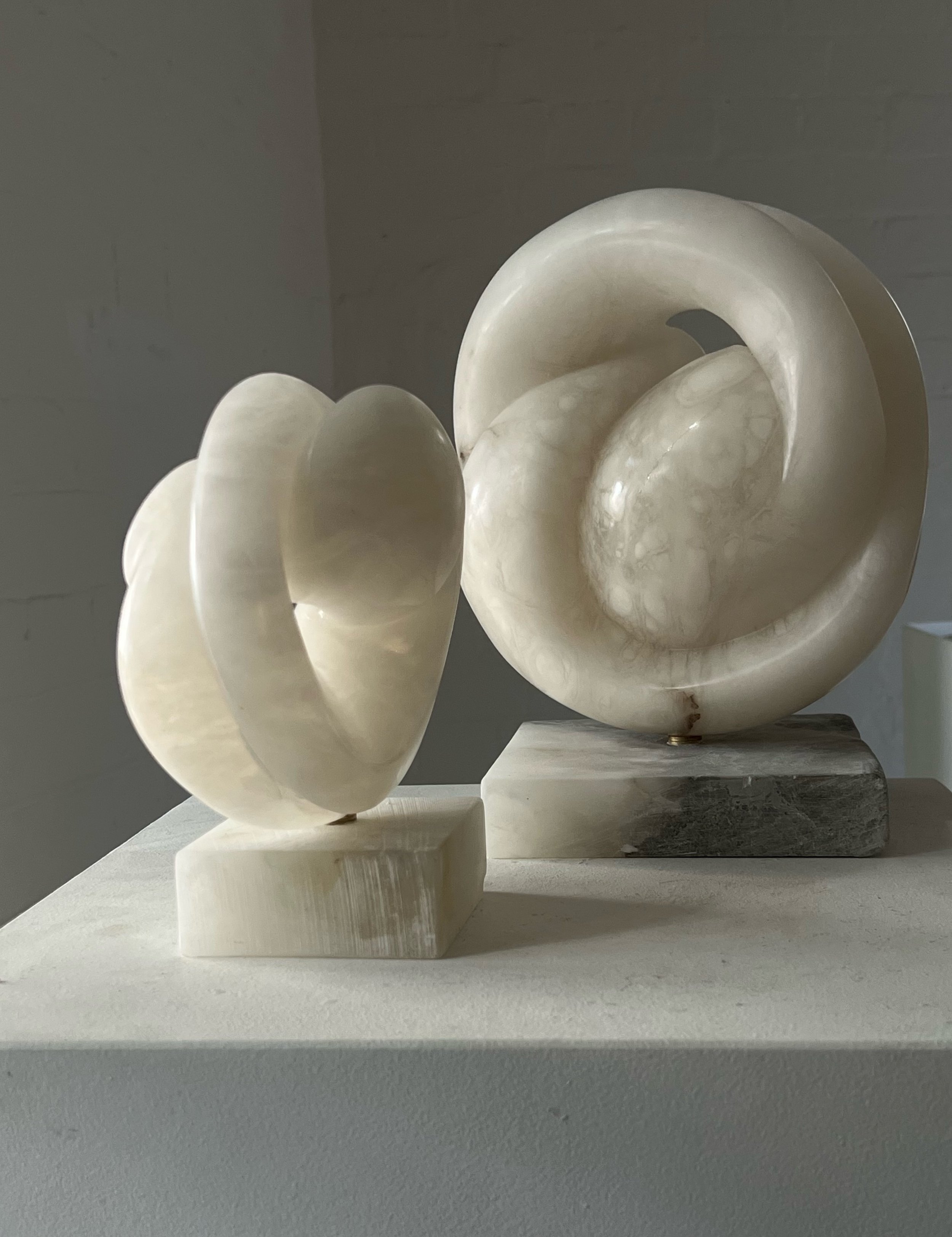Talking Practice: Carol Lehrer Crawford
Above: Carol working in her Studio.
Carol Lehrer Crawford is an artist practicing in Sydney, Australia. She creates sculptures in a variety of materials including alabaster, marble, soapstone, bronze and plaster. She works interpretively, and is recognised for her organic interlocking feminine forms. We chatted with Carol about her creative practice and what inspires her.
We’d love to know your background and your journey to becoming an artist:
I had always been fascinated with art and it was in the early 2000’s when I decided to start attending classes with Tom Bass AM that my sculpture journey began. (You could say I came to sculpture late in my life.) Tom was an incredible human who imparted such great knowledge and philosophy, with generosity. I felt privileged to be able to study in his atelier studio. Classes with Tom were not always easy – he’d really challenge you – but I take to a challenge and considered his comments seriously even though they sometimes hurt. You must let go of pride and absorb at all stages of your practice; you can never stop learning. Tom imbued me with a way of seeing that stays with me all these years later as I work with alabaster or any other material.
Tell us about your practice and creative process?
My creative process is fluid and organic. If I am carving stone, it starts with the choice of the raw stone and from there I simplify and if it’s too ‘simple’ I complicate. It’s a very hard thing to articulate as my carving process is more like an inner conversation, between me and the stone where we both speak to each other, listen, and adjust as required. Flexibility is also a factor in my process, not getting too caught up in getting the stone to do what I want - the final sculpture should be what we both are happy with.
What inspires your practice?
Nature and the human form in an obvious way, however I am inspired by past experiences and feelings.
How did you first discover alabaster?
I visited Volterra, Italy around 2010, which is the home of Italian alabaster and where museums are filled with Etruscan alabaster cinerary urns and alabaster artisans fill the streets. I bought a raw ‘nodule’ or two which I carried back to Australia and carved at TBSSS. I still have this sculpture and distinctly remember the stone in its raw form – it was like a cauliflower. The fascination grew from that first experience and as the alabaster was hard to source and rare in Australia, I tended to treat it differently to American sculptors who had more accessibility to the stone. I preserved as much of the stone as possible and tried to create a simple curvaceous organic form. Around this time, my daughter went to live in NYC and via a recommendation, I discovered a wonderful sculpture supply store that had a basement filled with all colours and sizes of alabaster from around the world.
Very soon, the fascination then became an obsession, where I found I was able to give ‘life’ to the raw nodules or eggs of alabaster. The brilliance and translucency of the stone and its lifelike characteristics endlessly fascinate me. You could say my work with alabaster was self-taught - but it was really the foundations of understanding form and my work over years studying with Tom Bass AM that formed my base.
How long does it take you to finish a sculpture?
This is very subjective and varies on the size, stone type and the form. Some small sculptures can really confound me and can take many weeks to months to years until I am satisfied and can call it ‘finished’, whilst others seem to have clear voices and I can bring out the form in a couple of weeks (although saying this, there aren’t that many that are that quick). I work on several sculptures at the same time. Some days I am into the final details or polishing, whilst others I’m energised and do the heavier chipping out and filing. I work by hand and polish by hand, no shortcuts.
Your sculptures are titled using female names, can you tell us about this and how you come to name your sculptures?
The female naming of my sculptures comes on two levels. Firstly, my forms are soft and rounded, unmeasured and sometimes with faults innately in them – all feminine characteristics. Hence this decision.
Then there is a deeper meaning to the naming of my sculptures because I grew up as a child of two Holocaust survivors – we had very few relatives growing up, no grandparents and only one uncle who survived. Our ‘family’ were the close friends of my parents that we called Aunt and Uncle. Family was sacrosanct. The naming of my sculptures is often after one of my relatives, or friends of my parents or beautiful Yiddish names that I find that match the character of the sculpture. I have created a family of sculptures who are all unique and give me a feeling of warmth every time I enter my studio or chance upon them in various places.
What projects are you working on at the moment?
I have almost completed a commission which has been an 18-month venture. The sculpture’s name is Ester III, it is a bronze sculpture which is cast from a direct plaster model which I modelled at TBSSS. Direct plaster is a medium I love working with because it is like carving stone, yet you have more flexibility as you can add (plaster) and take away to your heart’s content. This process was also quite technical, as the sculpture was getting cast in bronze and I have had to work closely with the foundry, Crawford’s Casting (no relation) and the client. It has been quite a different process to stone carving, but one I have loved. Installation is due by the end of June.
Do you have any favourite artists?
Oh, yes. My female heroine artists are Barbara Hepworth and Georgia O’Keeffe. I’ve travelled to both their homes, Hepworth’s in St Ives, England which gives a great insight into her practice and life. And then, I’ve visited New Mexico - Santa Fe and Abiquiu and seen the incredible landscape and home that influenced O’Keeffe so strongly. From these experiences I learned that art comes from within and is influenced by your environs.
Michelangelo and Bernini are also awe-inspiring classical stone sculptors whose works are the pinnacle of perfection.
Then there is Anish Kapoor who pushes alabaster to its maximum and does something with it that I could never do or even dream of – he makes me dream though.
Anything else you’d like to share?
For many years now I have been on the Board of the Tom Bass Sculpture Studio School and in recent years I have been appointed the Chair of the School. The ethos and classical teaching methods of Tom lives on in this very special place and I am very privileged to be able to help others gain a love of sculpture. The School is like a family, and is full of very committed and talented people.
You can view Carol’s website here, or follow her on Instagram here.
Carol is running a 2 Day Alabaster Carving Workshop at Tom Bass Sculpture Studio School in July. The workshop is sold out, but get in touch here, to join the waitlist.
Image details:
Image at top: Carol at work in her studio.
Middle images: left: Ruthie (brown calcite alabaster) and friends. Right: Chana.
Bottom images: left: Sylvia, bardiglio alabaster. Right: Manya and Little Leila.




